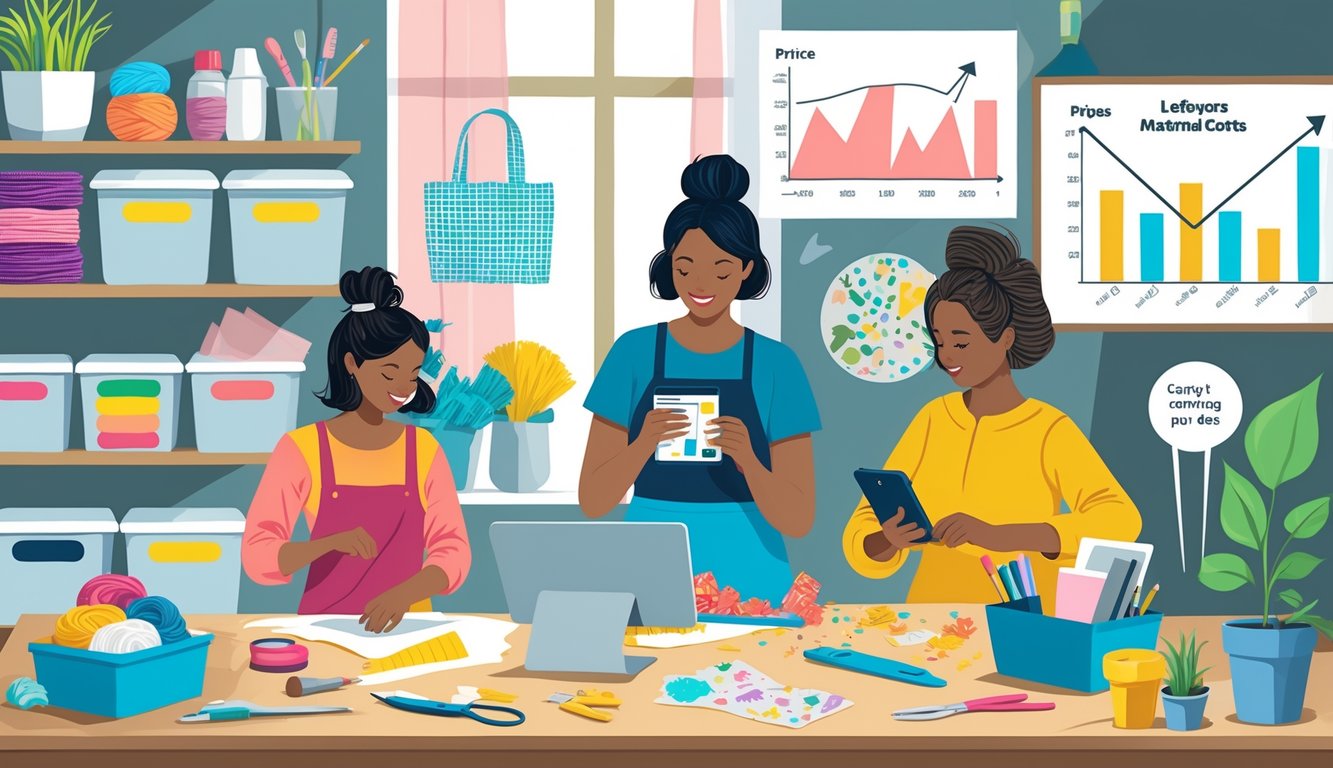
Collaborating Within Crafting Communities
Trying to stretch every penny—why is yarn so expensive? I swear, I’ve learned more from random DMs, awkward swaps, and that time someone handed me half a glue stick than from any finance blog. It’s not glamorous, but it works.
Sharing Resources and Materials
Let’s be honest: every crafter I know has a box of tangled thread and a bag of mismatched buttons somewhere, probably under a pile of receipts or half-finished projects. We’re all hoarders, right? Tina—yeah, that Tina—claims she saved $70 last year by just borrowing embroidery hoops from everyone else. She’s got a spreadsheet. I don’t trust her math, but nobody double-checks, so whatever.
And the so-called “accountability” thing? Not just a motivational poster. I read somewhere (Craft & Hobby Association, if you care) that teaming up makes people 27% more likely to actually finish something. Which is hilarious, because I can’t even get through a scarf on my own. When we get together, we just dump all our scraps on the floor—random glue, off-brand Mod Podge, those weird knitting needles with the label half-ripped off. Swapping even tiny bits (foil, washi, dried flowers) saves me from those 11pm panic-buying sprees for a single square of felt. Last week, someone finally made a shared Google Sheet to track who’s hoarding what. Should’ve done it sooner. If you’re the organizational type, there’s more about this on crafters’ networks, but I’m not that person.
Participating in Local Swap Events
My first craft swap? Absolute chaos—three grandmas, a cosplayer, and a retired engineer fighting over sequins. I bartered a vintage ribbon for safety eyes and immediately regretted it. Local swaps save money, no question, but nobody talks about the markup on embellishments (it’s a scam, honestly).
Everyone brings their “bad buys”—vinyl, unused patterns, neon felt—and suddenly, we’re all expert traders. Facebook groups, rec centers, yarn shops—swaps pop up everywhere. Sometimes you’ll find stuff you missed online, like that limited-edition paint set I scored for two bucks and some stale cookies. I think I saved $40 that day, and didn’t even have to pretend to like the weird shiny fabric. If you think I’m exaggerating, check out Crafty Money Maker for the real deal.
Tracking Expenses and Measuring Savings
Why do buttons cost $7? I’m hunched over receipts, grumbling, poking at spreadsheets, and trying to catch where my money’s leaking out. Sometimes I use sticky notes, sometimes random napkins, but mostly I just keep adding up numbers and swearing.
Creating a Materials Expense Tracker
I tried writing material costs on napkins. Lost them. Google Sheets? Lifesaver. I’ve got columns for item, date, store, cost, quantity, and a special one for “dumb mistakes” (Dritz needles, size 8, bought them twice last month).
Color codes help—red means “ouch,” green means “score.” Once, I got $12 off silk thread at Joanns. That felt like winning the lottery. Some online templates are so cute they guilt me into checking progress, like this one.
Tracking’s not just about numbers. It’s about catching when “eco-cotton” jumps from $10 to $14 and suddenly I’m sewing with muslin for practice. I set budgets, sometimes daily limits (especially when I’m on a spree), and use formulas for percent savings when coupons miraculously stack. Seeing it all together? Kind of a slap in the face, but at least I know what’s happening.
I even track “stash worth” because, honestly, who knows how much unused wool is sitting in my closet until I add it up? It’s depressing, but necessary unless you want to keep pretending you’re saving money while drowning in felt.
Evaluating Cost-Effectiveness of Projects
After I finish something, I scribble down time, cost, scraps I reused (last month, leftover linen saved me $4). Sometimes I sell, sometimes I give stuff away, sometimes I just hang it up and stare at it. Do I ever charge for labor? Nope. Market rates say I should, but Etsy sellers would laugh at my $3/hour.
Here’s what bugs me: price-per-project swings like crazy. Felted acorns? Cheap. Beaded bags? Budget black hole. When I plug it all into my tracker, it’s obvious which projects eat up my cash. That’s when I switch gears—less expensive stuff, more quick crafts.
ROI in crafting? Sure, I tried. Six hand-knit hats cost me $48 in yarn, store-bought would’ve been half that. Still can’t stop. Sometimes “savings” is just using up scraps; sometimes it’s a total fail and I’m left with half a jar of glitter and a lesson learned. Knowing the real cost isn’t about feeling bad, it’s about guessing better next time—and maybe saving enough for yet another “emergency” glue gun when the old one melts. Hidden savings exist, but only if you look for them.
Adapting to Ongoing Market Changes
Glue cost me 20% more yesterday than last week. I just read about a batting shortage and, boom, prices went nuts. No time to panic—stuff disappears, price alerts flood my inbox, and my supplier tries to convince me particle board is “basically birch.” Adjust fast or get buried in inventory I can’t afford.
Staying Informed About Material Price Trends
I’m not psychic about pricing. Last spring, cotton shot up overnight. Etsy sellers griped in my forums, so I caught it early. Now I watch supplier emails (they hide price hikes in the fine print), Facebook groups, and the occasional manufacturer alert. If you only check the local craft store, you’re at least a week behind.
A supplier once told me: big price jumps hit right after freight surcharges go public. I keep a table of my must-haves, average prices for the year, and try to guess the future with industry projections. AI forecasting? Sure, but it’s never right. Most of the time, I just listen for small manufacturers freaking out on Instagram before the big stores catch up. Set a Google Alert. Seriously, it’s saved me more than once.
Adjusting Crafting Plans as Prices Fluctuate
Prices spike, I throw out my plans. Two quilt designs bit the dust this week because wool blend went up $4 a yard. Substitutions? Always mess things up. When shadow box supplies get expensive, I grab unfinished pine, paint it, and hope nobody notices. I plan, but I never assume I’ll finish with my original supply list.
Sometimes I switch to student-grade acrylics or poly-cotton when commissions need to stay cheap. There’s no magic fix, but swapping materials or skipping embellishments can save a whole batch. When I’m down to scraps, I prototype tiny stuff, just to see what works if prices stay high.
Swapping project categories on the fly? Did it last season—jewelry findings doubled in price, so I made tote bags instead. Diversifying is the only way I’ve kept money coming in when the market’s wild. It never looks pretty, but my half-written spreadsheets and supply lists remind me: flexibility isn’t a strategy, it’s survival.



